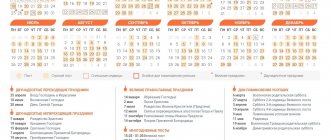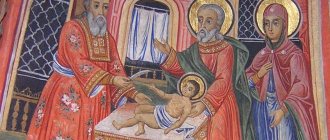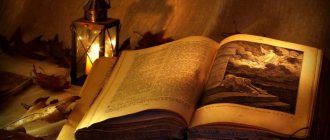What does the word "meeting" mean?
Meeting of the Lord.
James Tissot. In Church Slavonic, “sretenie” means “meeting.”
The holiday was established in memory of the meeting described in the Gospel of Luke, which took place on the fortieth day after the Nativity of Christ. On that day, the Virgin Mary and the righteous Joseph the Betrothed brought the baby Jesus to the Temple of Jerusalem to make the legally established thanksgiving sacrifice to God for the firstborn.
Easter Hours instead of Compline and Midnight Office.
From the second week after the Feast of the Ascension of Christ, you can again read the usual morning and evening prayers.
Also, instead of the prayer “It is worthy to eat” it is read:
“The angel cried out with grace: Pure Virgin, rejoice! And again the river: Rejoice! Your Son is risen three days from the grave and raised up the dead; people, have fun! Shine, shine, new Jerusalem, for the glory of the Lord is upon you. Rejoice now and be glad, O Zion. You, Pure One, show off, O Mother of God, about the rising of Your Nativity.”
Dear friends, I hope that this article helped to find out what the Ascension of the Lord means for every Christian.
What kind of sacrifice had to be made after the baby was born?
According to the Old Testament law, a woman who gave birth to a boy was forbidden to enter the temple for 40 days (and if a girl was born, then all 80). She also had to bring a thanksgiving and cleansing sacrifice to the Lord: a one-year-old lamb for thanksgiving, and a dove for the remission of sins. If the family was poor, a dove was sacrificed instead of a lamb, and the result was “two turtle doves or two dove chicks.”
In addition, if the first-born in the family was a boy, on the fortieth day the parents came with the newborn to the temple for a rite of dedication to God. It was not just a tradition, but the Mosaic Law, established in memory of the exodus of the Jews from Egypt - liberation from four centuries of slavery.
The Blessed Virgin Mary did not need to be purified because Jesus was born from the virgin birth. However, out of humility and in order to fulfill the law, she came to the temple. Two doves became the purifying sacrifice of the Mother of God, since the family was poor.
Prayers for the Holiday
Troparion for the Presentation of the Lord, tone 1
Rejoice, Blessed Virgin Mary, / from You the Sun of Truth, Christ our God, has risen, / enlightening those in darkness. / Rejoice, you too, the elder righteous, / received into the arms of the Liberator of our souls, / / yes who promises us resurrection.
Translation: Rejoice, blessed Virgin Mary, for from You has arisen the Sun of righteousness, Christ our God, who enlightens those in darkness. Rejoice also, O righteous elder, who has accepted into the arms of the Liberator of our souls, who gives us resurrection.
Kontakion of the Presentation of the Lord, tone 1
You sanctified the womb of the Maiden with Your Nativity/ and blessed the hand of Simeon,/ as it was fitting, having foreshadowed,/ and now you have saved us, O Christ God,/ but pacify your life in battles// and strengthen the people, and Who has loved you, the only one who loves mankind.
Translation: Having sanctified the womb of the Virgin by Your birth, and blessed the hands of Simeon, in advance, as it should have been, and now You have saved us, O Christ God. But protect Your people with peace amidst wars and strengthen those whom You have loved, O One Lover of Mankind.
Who is Simeon the God-Receiver?
According to legend, when the Virgin Mary crossed the threshold of the temple with a baby in her arms, an ancient elder came out to meet her.
Double-sided tablet icon from the second quarter of the 15th century. Sergiev Posad Museum Reserve (Sacristy)
His name was Simeon. In Hebrew, Simeon means “hearing.”
Tradition says that Simeon lived 360 years. He was one of the 72 scribes who, in the 3rd century BC. At the behest of the Egyptian king Ptolemy II, the Bible was translated from Hebrew into Greek.
When Simeon was translating the book of the prophet Isaiah, he saw the words: “Behold, the Virgin will be with child and give birth to a Son” and wanted to correct “Virgin” (virgin) to “Wife” (woman). However, an Angel appeared to him and forbade him to change his word, promising that Simeon would not die until he was convinced of the fulfillment of the prophecy. This is stated in the Gospel of Luke: “He was a righteous and pious man, looking forward to the consolation of Israel; and the Holy Spirit was upon him. It was foretold to him by the Holy Spirit that he would not see death until he saw Christ the Lord” (Luke 2:25-26).
On the day of the Presentation, what the elder had been waiting for all his long life was fulfilled. The prophecy has come true. The old man could now die peacefully. The righteous man took the baby in his arms and exclaimed: “Now, O Master, you are sending Your servant away in peace, according to Your word, for my eyes have seen Your salvation, which You have prepared before the face of all nations, a light to enlighten the Gentiles and the glory of Your people Israel” (Luke 2:29-32). The church named him Simeon the God-Receiver and glorified him as a saint.
In the 6th century, his relics were transferred to Constantinople. In 1200, the tomb of Saint Simeon was seen by a Russian pilgrim - Saint Anthony, the future Archbishop of Novgorod.
Candlemas. Andrea Celesti. 1710.
Bishop Theophan the Recluse wrote: “In the person of Simeon, the entire Old Testament, unredeemed humanity, passes into eternity in peace, giving way to Christianity...” In remembrance of this evangelical event, the Song of Simeon the Receiver of God is heard every day in Orthodox worship: “Now you let go.”
Who is Anna the Prophetess?
On the day of the Presentation, another meeting took place in the Jerusalem Temple. In the temple, an 84-year-old widow, “daughter of Phanuel,” approached the Mother of God. The townspeople called her Anna the Prophetess for her inspired speeches about God. She lived and worked at the temple for many years, “serving God day and night with fasting and prayer” (Luke 2:37-38).
Anna the prophetess bowed to the newborn Christ and left the temple, bringing the news to the townspeople about the coming of the Messiah, the deliverer of Israel. “And at that time she came up and glorified the Lord and prophesied about Him to all who were waiting for deliverance in Jerusalem” (Luke 2:36-38).
How did they begin to celebrate the Presentation of the Lord?
The Presentation of the Lord is one of the most ancient holidays of the Christian Church and completes the cycle of Christmas holidays. The holiday has been known in the East since the 4th century, in the West since the 5th century. The earliest evidence of the celebration of the Presentation in the Christian East dates back to the end of the 4th century. At that time, the Meeting in Jerusalem was not yet an independent holiday, but was called “the fortieth day from the Epiphany.” The texts of the sermons that were delivered on this day by Saints Cyril of Jerusalem, Basil the Great, Gregory the Theologian, John Chrysostom and other famous hierarchs have been preserved. But until the 6th century, this holiday was not celebrated so solemnly.
Candlemas. Rogier van der Weyden. Fragment
Under Emperor Justinian (527-565), in 544, Antioch was struck by a pestilence that killed several thousand people every day. During these days, one of the Christians was given instructions to celebrate the Presentation of the Lord more solemnly. The disasters truly ceased when an all-night vigil and religious procession were held on the day of the Presentation. Therefore, the Church in 544 established the solemn celebration of the Presentation of the Lord.
Since the 5th century, the names of the holiday have taken root: “Feast of the Meeting” (Candlemas) and “Feast of Purification.” In the East it is still called Candlemas, and in the West it was called the “Feast of Purification” until 1970, when a new name was introduced: “Feast of the Sacrifice of the Lord.”
In the Roman Catholic Church, the Feast of the Purification of the Virgin Mary, dedicated to the memory of the bringing of the baby Jesus into the temple and the purification rite performed by his mother on the fortieth day after the birth of her first child, is called Chandeleur, i.e. lamp. Lamp, feast of the Mother of God Gromnichnaya (feast of the Fiery Mary, Gromniyya) - that’s what Catholics call it.
Our Liturgical Charter - Typikon says nothing about the consecration of candles (and water) on the Feast of the Presentation of the Lord. The old missals do not contain anything like this. Only after 1946 did the rite of blessing candles for the Presentation of the Lord begin to be printed in breviaries, and this was associated with the transition from the union of the population of the regions of Western Ukraine. The custom of consecrating church candles on the feast of the Presentation of the Lord was transferred to the Orthodox Church from Catholics in the 17th century, when Metropolitan Peter Mogila edited the “Trebnik for the Little Russian dioceses.” For editing, in particular, the Roman missal was used, which described in detail the order of processions with lit lamps. In our country, the Latin Sretensky rite never took root, but the rite, thanks to Peter Mogila, remained (neither the Greeks nor the Old Believers have any trace of it). Therefore, in many dioceses of the Russian Church, candles are blessed either after the prayer behind the pulpit (like the rite of the Great Blessing of Water, which is “inserted” into the liturgy), or after the liturgy at a prayer service. And there are places where there is no custom of blessing candles. The “magical” attitude towards Sretensky candles is a relic of the pagan ritual of honoring fire, associated with the cult of Perun, and called “gromnitsy”.
Candlemas. Gerbrandt van den Eeckhout.
Features of worship
Presentation is one of the Lord's feasts, dedicated directly to Christ, but in its liturgical content it is extremely close to the feasts of the Theotokos. Therefore, the features of the service of the Presentation in the Temple are inherent in the feast of the Mother of God with elements of the Lord's feast, in particular, in the Liturgy there are figurative antiphons, but there is an introductory verse: “The Lord has spoken His salvation, revealing His truth before the tongues.”
From open sources
On the icon of the holiday, the images of Christ and the Mother of God are equal in significance: the baby Savior sitting in the arms of the God-Receiver Simeon, who receives the Savior in his arms and appears as if the old world is filled with Divinity, and the Mother of God, who has gone out on the way of the cross - the giving of Her Son to save the world.
Important: if Candlemas falls on the Monday of the first week of Lent, which happens very rarely, the festive service, according to church regulations, is moved to the previous day.
Also on the holiday, it is customary for the church to bless candles and distribute them to believers.
What does the “Softening Evil Hearts” icon mean?
Associated with the event of the Presentation of the Lord is an icon of the Most Holy Theotokos, which is called “The Softening of Evil Hearts” or “Simeon’s Prophecy.” It symbolically depicts the prophecy of Saint Simeon the God-Receiver, pronounced by him in the Jerusalem Temple on the Day of the Presentation of the Lord: “A weapon will pierce your own soul” (Luke 2:35).
The Mother of God is depicted standing on a cloud with seven swords piercing her heart: three on the right and left and one at the bottom. There are also half-length images of the Virgin Mary. The number seven signifies the fullness of grief, sadness and heartache experienced by the Mother of God in her earthly life. Sometimes the image is replenished with the image of the deceased Infant of God on the knees of the Mother of God.
What signs exist for Candlemas?
In Rus', this holiday was used to determine the start of spring field work. According to popular beliefs, Candlemas is the border between winter and spring, as evidenced by popular sayings: “Candlemas - winter meets spring and summer,” “Sun for summer, winter for frost.”
By the weather on the feast of the Presentation, peasants judged the coming spring and summer, the weather and the harvest. They judged spring like this: “What is the weather on Candlemas, so will spring.” It was believed that if there was a thaw on Candlemas, spring would be early and warm; if it was a cold day, expect a cold spring. Snow falling on this day means a long and rainy spring. If snow blows across the road on Candlemas, spring is late and cold. “On Candlemas morning, snow is the harvest of early grain; if at noon - medium; if it’s late in the evening.” “On the Meeting of Drops - the wheat harvest.” “At Candlemas, the wind brings fertility to fruit trees.”
Read a fragment from Joseph Brodsky’s poem “Candlemas” here>>
Question answer
Many parents ask what does it mean to be born on Ascension? The priests answer that there is no need to invent anything special. As usual, the child must be baptized when the time comes. Children born on major holidays are distinguished by excellent health, a bright mind, and throughout their lives they should carry goodness and purity.
Many believers are interested in what prayers to read from Easter to Ascension. During these 40 days, from April 8 to May 17, you need to read.
On Bright Week - the 1st week after Easter, they do not read morning and evening prayers, but read the Easter Hours, which are in most prayer books.
If you are preparing for communion, then instead of the penitential canon to the Lord and the canon to the Most Holy Theotokos, the canon of Easter and the Follow-up to Holy Communion are read.
All prayers must be preceded by reading the Easter troparion three times:
“Christ is risen from the dead, trampling down death by death, and giving life to those in the tombs.”
Psalms and prayers, starting with the Trisagion (“Holy God…”) through “Our Father…”, as well as troparia after it, are not read at this time.











